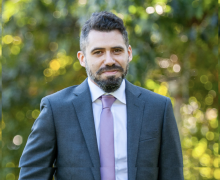
Associate Professor and Graduate Chair of Criminology
Ph.D., Public Policy, University of California, Berkeley (2013)
M.A., International and Development Economics, Yale University (2004)
B.S., Industrial & Labor Relations, Cornell University (2003)
Research Interests
My current research focuses on the costs and benefits of policing, the preferences of police officers, place-based crime prevention and the determinants of crime victimization. I am also interested in the advancement of social science research methods and have written on topics such as measurement errors in observational data, measuring spatial crime concentration and the empirical implications of administrative data linking. Prior to joining the faculty at Penn, I spent two years at the University of Chicago Crime Lab where I remain an affiliated researcher. I am also a Senior Fellow at the Niskanen Center and a faculty research fellow at the National Bureau of Economic Research.
Selected Publications
Policing
“The Professional Motivations of Police Officers,” Working Paper (with Felipe Goncalves)
"Does Proactive Policing Really Increase Major Crime? Accounting for an Ecological Fallacy," Working Paper (with David Mitre Becerril and Morgan Williams Jr.)
“Police Force Size and Civilian Race,” American Economic Review: Insights (with Ben Hansen, Emily Weisburst and Morgan Williams Jr.)
“Can Precision Policing Reduce Gun Violence? Evidence from Gang Takedowns in New York City,” Journal of Policy Analysis & Management (with Michael LaForest and Jacob Kaplan)
“How Many Complaints Against Police Officers Can Be Abated by Incapacitating a Few Bad Apples,?” Criminology & Public Policy (with Jacob Kaplan)
“More Cops, Fewer Prisoners?,” Criminology & Public Policy (with Jacob Kaplan)
“Are U.S. Cities Underpoliced? Theory and Evidence," The Review of Economics and Statistics (with Justin McCrary)
Place-Based Crime Prevention
"Can Deterrence Persist? Long-Term Evidence from a Randomized Experiment," Criminology & Public Policy (with David Mitre Becerril, Sarah Tahamont and Jason Lerner)
“Reducing Crime Through Environmental Design: Evidence from a Randomized Experiment of Street Lighting in New York City,” Journal of Quantitative Criminology (with Ben Hansen, Jason Lerner and Lucie Parker)
“Street Light Outages, Public Safety and Crime Attraction,” Journal of Quantitative Criminology (with Jacob Kaplan and Michael LaForest)
“Ambient Lighting, Use of Public Space and Perceptions of Public Safety: Evidence from a Survey Experiment,” Security Journal (with Jacob Kaplan)
Victimization
"A New Racial Disparity in Traffic Fatalities," NBER Working paper (with Maxim Massenkoff)
"Comparing Risks of Firearm Related Death and Injury Among Young Adult Males in Selected US Cities to Wartime Service in Iraq and Afghanistan," JAMA Network Open (with Brandon del Pozo, Alex Knorre and Michael Mello)
"Activity-Adjusted Crime Rates Show That Public Safety Worsened in 2020," Proceedings of the National Academy of Sciences (with Maxim Massenkoff)
“The Minimum Legal Drinking Age and Crime Victimization,” Journal of Human Resources (with Ben Hansen and Rachel Ryley)
“More Sneezing, Less Crime? Health Shocks and the Market for Offenses,” Journal of Health Economics (with Shooshan Danagoulian and Monica Deza)
Research Methods
"No Ground Truth? No Problem: Improving Administrative Data Linking Using Active Learning and a Little Bit of Guile," Working Paper (with Sarah Tahamont, Zubin Jelveh, Melissa McNeill, Shi Yan and Ben Hansen)
“Measuring Marginal Crime Concentration: A New Solution to an Old Problem,” Journal of Research in Crime & Delinquency (with Jacob Kaplan and Maria Cuellar)
“Dude, Where’s My Treatment Effect? Errors in Administrative Data Linking and the Destruction of Statistical Power in Randomized Experiments,” Journal of Quantitative Criminology (with Sarah Tahamont, Zubin Jelveh, Shi Yan and Ben Hansen)

